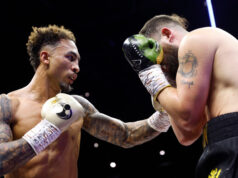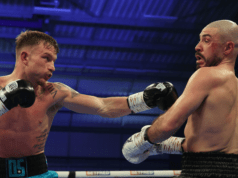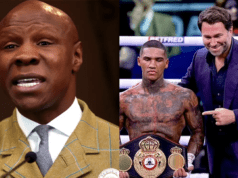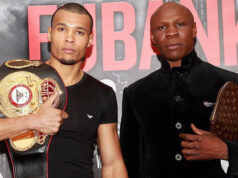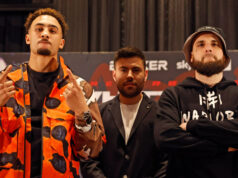Looking Back at One of Boxing’s Glory Times: The 1980s with Hearns, Hagler, Leonard and Duran
Which of the great fighters from the 1980s was the best of them all? A logical slant on this topic would surely produce one result, that being Sugar Ray Leonard, he beat them all and he embarrassed the best. However, boxing rarely allows such ease within its’ great debate. What follows is an analysis of four of the most formidable fighting machines that ever graced the ring. So different in their styles but so alike in the legacy they would leave behind, GREATNESS. Who really was the king of kings? Hearns, Hagler, Leonard or Duran?
Thomas Hearns defied biological reasoning. A lanky welterweight, his nickname of the “Hitman” was not too far from the truth. His appearance was somewhat deceptive, the hands held explosive power, the height held great range. The one letdown in Hearn’s makeup was his lack of reliability when it came to being hit with anything substantial. Do not let this fool you however.
Hearns was an extremely talented fighter and much more proficient than the average puncher. The Hitman holds the distinction of being boxing’s first world Champion to hold titles at 6 different weight classes, from Welterweight up to cruiserweight (although the latter was not a “big 4” championship.) His height of 6’1″ allowed him to move up effectively in weight without compromising his murderous power.
His ascent to greatness began with a win over capable Mexican champion, Pipino Cuevas for the WBA welterweight belton the in August of 1980. The fight showcased a number of things from the Kronk gym disciple, namely his sharp jab and ability to box effectively from range. Cuevas, who had previously made 11 defenses of the championship, was feared and known to carry considerable power as shown by the 31 knockouts from the 35 wins on his record.
Hearns boxed steadily from the first bell, employing consistent left jab/right cross combinations to rock the challenger. The end appeared to be near towards the end of the first, but Hearns apparent impatience to spell the end would make this a two round affair, ending up with Cuevas being brutally knocked out by a bomb of a right hook in the second, thus entering the Motor City Cobra into boxing history. A number of successful defenses followed (against Luis Primera, Randy Shields and Juan Pablo Baez) all ending unsurprisingly in knockouts for the champion. The public was now clamouring for unification, the Hitman was on a collision course with the WBC champ and future Hall of Famer, Sugar Ray Leonard.
For Hearns, Leonard (as a man) was both a benefit and a hindrance. As with boxing’s great rivalries the example of the “fabulous 4” is one that applies to the old adage that the fighters “couldn’t live with each other, couldn’t live without each other”. The basic reasoning behind this is that each fight that Hearns, Hagler, Duran and Leonard had, regardless of a win or loss for the respective fighters facing each other, it helped advance their careers.
The fights between these men live long in the memory because of the excitement they created and the significance they harbored. Hearns and Leonard was no different in its value and the overall spectacle. The fight was hugely significant for 2 reasons; firstly, it was both fighters’ chance to unify the splintered welterweight championship, with a chance of Hearns enhancing his prize fighting resume by defeating the poster boy for boxing and adding to his undefeated record.
Secondly, for Ray, a win meant that his embarrassing loss to the legendary Manos de Piedra would be forgotten even more readily and dismissed as a mere blemish on the champ’s record, especially as the infamous “no mas” encounter restored the sporting public’s faith in Ray’s damaged reputation. Anything following that would be a blessing, especially an undisputed title fight win against another extremely well rounded adversary.
The fight the world was anticipating occurred on September 16, 1981. It was remarkable in its pattern. Hearns appeared to have arrived to do what the Hitman always did. The strategy was evident from the early rounds, stalk Leonard a la the Duran fight, although with less conceivable aggression and use a steady jab to deliver an opening. For five rounds, this indeed remained the status quo. Leonard seemed unwilling to be drawn into a mid ring battle, perhaps due to his lack of success in the former Duran fight. Five rounds passed, and Hearns was making this look easy.
However, a landslide was not on Sugar’s agenda. From the sixth it seemed that dents in Hearns were beginning to surface. Leonard was now beginning to put punches together, using his superior speed and looked as though he was preparing to close the gap on the judges’s cards. This, fortunately for Hearns, was not the case and upon gaining his composure he began to continue racking up points with a ramrod jab and good reflexes that were able to avoid the little that WAS returning from Sugar Ray, who from rounds 7-12 looked as though he was waiting for a mistake to occur. A hunter stalking his prey, throwing nothing and obviously content to watch and wait for results.
And the wait was fruitful, as the American fight announcer commented, “Leonard has stored a lot of punches” he began his barrage upon spotting an opening. Leonard was a renowned finisher of fights in his prime. With a heavy welt around his right eye continuing to be agitated and unable to win the fight on points, the WBC champion went in for the kill. Jabs, hooks rights and lefts all reached their destination and Hearns who by now was looking helpless, was exhausted. The bell saved him from further punishment in the 13th, but it was clear to all that the end was near for Hearns barring some defensive effort, which did not appear to be forthcoming from Hearns’ vast repertoire.
The referee mercifully called an end to the contest in the 14th, with 1:15 remaining. The legs were gone, along with the will of the WBA champion, who had already been pummelled to the point of falling through the ropes by Leonard. Leonard was a king again, having rectified his one defeat to Duran, he had now beaten his only other challenger to supremacy at welterweight, forcing Hearns to consider the many options available to him. A rematch looked the most obvious choice, but this opportunity did not surface until 1989 and ended without a gained measure of revenge for the Hitman despite 2 knockdowns on his way to a controversial draw.
Back to 1981, Hearns still only 22, made the decision that the only way is up (in weight that is) and forayed into the super welterweight division. Following a number of tune up fights at middleweight, Hearns sought the WBC light-middleweight champ Wilfred Benitez to bring him good fortune. Benitez had suffered the same fate as Hearns in 1979 against Ray Leonard, although he was trailing on the scorecards, unlike Hearns, when the contest was halted with only seconds remaining in the 15th and final round.
Hearns won the fight on a majority verdict and entered arguably the most successful period of his boxing career. The champion made 3 successful defence of the championship, including a stunning second round knockout of Panamanian hard man Roberto Duran that led the way to a mouth watering clash between Marvelous middleweight king Marvin Hagler for he undisputed championship.
The fight is a landmark in both fighters’ respective careers. Simply Called “The War”, no other introduction is needed for an encounter that produced 3 of the most thrilling rounds of boxing ever viewed in the ring. The intimidating Hagler, the bald brooding macho man, saw this as simply another night’s work. An opportunity to consolidate his position in the history books even further since becoming the most dominant middleweight since the reign of Argentine Carlos Monzon, a man he will forever be compared to in the debate of the finest middleweights of all time.
For Hearns, this fight offered redemption from the Leonard mishap and a chance to capitalise on the fearsome battering he handed out to former Ray Leonard conqueror Roberto Duran. The knockout harbored added favoritism towards Hearns when facing Hagler, as the latter had only managed a laboured 15 round win over Duran, far less impressive than his imminent foe.
“The War” took place on April 15, 1985 in Las Vegas, Nevada. The fight started at a blistering pace. The Marvelous one, usually content with patiently and effectively boxing his way to an opening using a switch hitting style and then going in for the kill, rushed to meet Hearns. The defending champion landed a vicious right hand, thus beginning his relentless pursuit of the Detroit Hitman.
Hearns looked shocked but was shaken into action. His response was to land his own combinations and match Hagler punch to punch. He was hindered considerably when Hearns was able to land a heavy right to the chin of Marvin, breaking his hand, and lessening his chances of victory.
The third round was the slowest of the three sessions. The champion was bleeding heavily from a laceration to the forehead and began headhunting the exhausted Hearns, who had mistakenly fought with aggression for the first two rounds and was beginning to slow noticeably. The legs were going, as was his hope of winning the battle. Hagler, now finding success from the southpaw stance with a good jab, readied himself for a big finish. After being cleared to continue fighting by Dr. Donald Romeo, who inspected his crimson masked forehead, Hagler launched his final deadly assault.
A stiff right began Hearn’s misfortune. The broken right hand was being used simply to paw by Hearns, who was exercising the use of lateral movement to try and avoid punishment. The strategy was in vain. Hagler smashed a heavy right into Hearns head, causing the challenger to turn away slightly while sporting a rueful grin. This slight sign of defiance was followed by another jolting right from Hagler, who following this, allowed Hearns to slump forward and eventually fall to his feet. Hearn’s flaws were highlighted ruthlessly once again. His worrying depletion of stamina and questionable chin had let him down just as it did in 1981, although this time it was a result of poor tactics rather than bad luck on the part of Hearns.
The Hagler fight was the last time that Hearns would fight for divisional dominance. His bravery and courage had made him a champion in the eyes of boxing fans. But when rating him in the order of the four individuals who defined 1980’s boxing it is hard to place him at the forefront. While many were in awe of his amazing punching power, his failure to replicate big performances against the other 3 elite individuals let him down considerably.
Roberto Duran aside, Hearns seemed incapable of rising to the occasion when the opponent in front of him was able to cope with his massive power and very slick “flicker” jab. Duran was simply outgunned, a blown up bruiser who had clearly seen better days. He had looked somewhat demoralized since the loss to Leonard and like Hearns, moved up in weight to escape the stigma of the “no mas” incident and forge a career revival at a higher weight. Duran appeared to be going through a period of revival, following a win over Davey Moore for the WBA light middleweight crown, after suffering two losses to Wilfred Benitez and the gifted but erratic Kirkland Laing in London.
The point to be made is that although Thomas Hearns beat a great on that fateful night in June 1984, it was undoubtedly the familiar shell of a great. It did not even allow Hearns the privilege of unifying the splintered junior middleweight division, due to the WBA stripping Duran of his version of the title prior to the contest.
This also plays a big part when rating Hearns in comparison with the other three great men. Every adversary of the fabulous 4 that Hearns encountered had seen at one time or another, undisputed glory.
This differs from the public and a fighter knowing that they are the best. The belt signifies a literal physical recognition that can be debated against, but claim to be the best will not be rebutted until a challenger enters the ring and takes over the mantle. Duran had this at lightweight, and as a result of his 8 year reign at the top is considered by many to be at the top of the all time list at that weight; Hagler had it at middleweight; and Ray Leonard at the expense of Hearns, dazzled at welterweight and later, though not so convincingly, at middleweight.
The chance never came for Hearns to discredit this claim, with talk of a rematch with Hagler ruled out after a Leonard comeback and the 1989 rematch with Leonard ruled a draw. While more title wins followed after Haglers win, the signs were clear. Hearns could be hurt and beat if pressed, this being demonstrated in an upset loss to Iran “The Blade” Barkley in 1988, which ended in a 3rd round TKO.
His last great display is widely recognized to be against WBA light heavyweight titlist Virgil “Quicksilver” Hill who was the second world champion to be beaten by Hearns after his TKO win over British WBC champion Dennis Andries in 1987. Hearns abandoned the power punching he had so often resorted to and capably boxed his way to a unanimous points decision broadcasting shades of his amateur background before he was transformed by trainer Emmanuel steward into something of a wrecking machine.
The lightly regarded WBU and IBO versions of the title were possessed by Hearns before Uriah Grant closed the Hearns’ story book for a while when beating him in 2 in 2000.
It is my belief that in any era besides the one he frequented, along with a pool of amazing talent, both in America and Europe, Hearns would have beat every man he faced. Every fighter faces their own demons, whether physical or mental, it was unfortunate for the Hitman that many of his demons took physical form. I do not wish to detract from Hearns achievements at all, merely provide a forum for debate for statements such as this…
Thomas Hitman Hearns, a lord amongst men, was,unfortunate. He entered in the wrong place at the wrong time. A man who crumbled in true heat, but should not be depreciated by anyone. He is a boxing great, in my opinion the poorest (if there is such a description) of the fabulous four but undoubtedly he is the one, true HITMAN.


